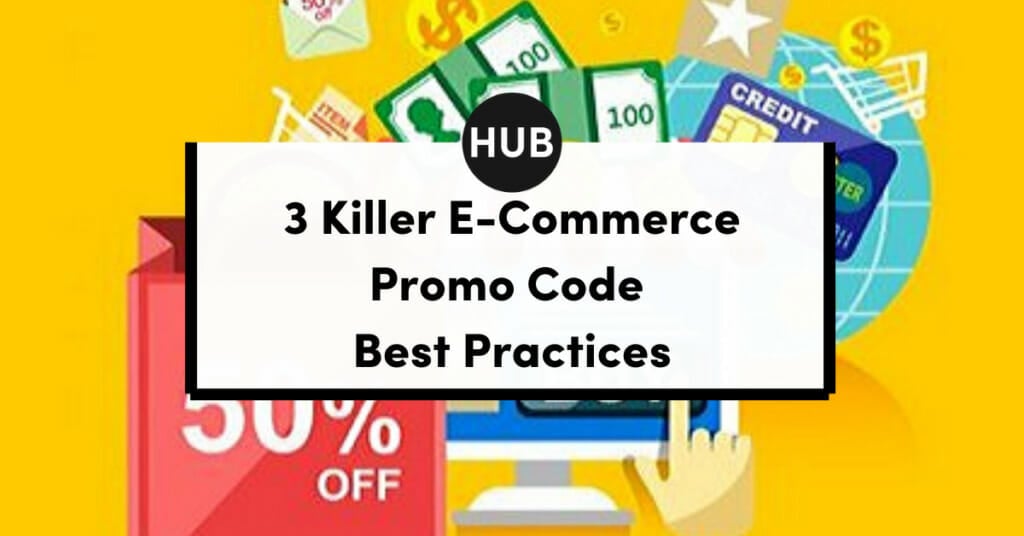In this article, we’re talking about 3 killer e-commerce promo code best practices instead of why you don’t want to go the standard route with coupons.
Everyone loves a good deal. But are you using the truly profitable e-commerce promo code best practices for your Shopify store?
Good deals attract customers. That’s why sales and promotion advertisements get sent out like wildfire by big retailers.
In the past decade, it’s been easier than ever to create an eCommerce store. But also, to take advantage of some of these same strategies that retailers use. Especially with Shopify.
One of those strategies is the coupon.
But does it do more harm than good?

Pretend for a moment that you’re shopping on this site.
What’s the first thing you think when you see the ‘Gift card or discount code’ box?
If you’re like most people, you start hunting for a coupon. Because you now know it’s a possibility to get a lower price.
This happens very often with some retailers. So often, that a Google search of their name tends to be suggested by Google with the word ‘coupon’.

Let’s talk about a few reasons why you don’t want to go the standard route with coupons and the 3 e-commerce promo code best practices to follow.
And more, how to offer it the right way.
Problems with Using Promo Codes
1) Potential Affiliate Fees

Say a customer comes to your Shopify store with a coupon code. There’s a percentage you have to pay if you use a coupon site or an affiliate’s code.
This isn’t that bad. Considering you might not have had the sale in the first place. If your affiliate didn’t send traffic your way.
But the customer may still have to enter the code. Which may lead them to think, “What if there’s a better code?”
2) Training the visitor to expect a deal each time

We’ve talked in-depth about how offering discounts can be like cocaine for your store’s health.
It feels good for the moment. But then you start training your customer base to need a bigger discount. Any time they want to buy something.
With that being said, gamification can be a solution. We’ll talk about that shortly.
Discounts can be great. But what you don’t want to do is to train your customers that the next sale is only around the corner. So, they hold off on buying from you until your next “flash sale.”

This is on top of another epidemic. Black Friday/Cyber Monday.
“Epidemic? But Bradley, that’s when I get so many of my sales!”
You see, every year retailers amp up Black Friday/Cyber Monday more and more. And every year, we train customers to shop during that window of time in Q4.
Despite having the surge of sales in that period, it doesn’t increase the entire Q4 revenue. It just concentrates it on the BFCM time period.
On top of that, retailers discount so heavily that it devours their margins.
Then what about customer acquisition costs? The cost of ads and the time spent planning spike up because everyone is doing the same thing. Having a BFCM sale.
3) Finding a better deal at another store

A study conducted by PayPal and comScore revealed an interesting fact. 27% of participants would abandon their cart. Why? To search for a discount code.
Is there an option to enter a coupon code? Then you’re pretty much promising the customer that there’s an opportunity to save money with you.
When you trigger this coupon hunting, you also tend to trigger comparison shopping. They find a better deal at another store and not buy with you at all.
What’s a Shopify store owner to do?
E-commerce Promo Code Best Practices for Your Shopify Store
1) Stop using discount codes

In case you were thinking all this was more trouble than it was worth. We’re going to play devil’s advocate. We’ll explain why stopping discount codes altogether isn’t the best choice either.
Coupon codes aren’t only for coupon sites to harvest and be something hunted down by cheapskates.
Practical Ecommerce analyzed 100 blog posts. These generated high traffic for a retail client of theirs. Over 50% of these posts featured a coupon code.
“I’ve seen blogs generate upwards of 20% of a retailer’s new customers. While blog traffic does take time for a retailer to build, the investment is worth it in terms of new customer acquisition.
And, as I saw from our quick study of those 100 posts, offering bloggers a coupon code — with an affiliate link in the code — is a good way to get coverage of your brand.”
When you have a relationship with a blogger. Who becomes an affiliate, who can reach a market that already trusts them, it’s a win-win-win.
2) Pre-discounted links

Shopify has implemented a way to natively apply a coupon code via a shareable link.
The ideal way would be to hide the box if the visitor arrives at your site through one of these links.
The discount gets applied and thus there’s no reason to show the coupon box.
But, there’s no way to hide the coupon box when directed to your store this way without extra coding.
3) Using self-hosted and self-promoted coupons

Creating a page of coupons and sharing them with customers is a big retailer strategy.
Macy’s will let you find a promo code that matches your cart’s items

Macy’s reported that 40% of the visitors to their special Promotions page ended up converting in the same session.[*]

Kohl’s offers coupons in a very similar style to Macy’s at the checkout.

Harbor Freight has a weekly physical and digital mailer of coupons. As well as a dedicated part of their site to coupons that can be currently used.
Not only does this help keep customers on your website for their session. It builds customer trust.
What Should I Do?

It’s difficult to account for all variables in split-testing coupon code methods. And say for certain that, yes, this is the best way to do it for my Shopify store.
There’s a lot more to it.
- Are you using an affiliate system to spread the buzz about your products?
- Are you spreading promo codes on coupon sites?
- Are you targeting specific customer segments that may or may not convert better?
- Are you sending out to your own email list to keep ad costs down so you can afford to discount products?
Your promo code has to be in line with your discount strategy and the expectations of your customers. The best way is a massive undertaking of cross-channel marketing.
Gamifying your store’s discount codes offer huge advantages.
Your customer feels like they actually won something. There’s a genuine chance he could win big.

Kohl’s did this far before apps as Wheelio did with their mystery coupon.
Using apps like Wheelio or Privy, you allow your customer to win a given coupon code amount. It’s a win-win for you and your potential customers.

There’s the actual chance of a visitor winning big savings, so it makes it that much more enticing

One of our clients, BathParlor, has had big success with this strategy. After a few days of implementing spin-to-win strategies, they were sitting at a 4% opt-in rate
Here’s another strategy we’ve found useful. Location-based dynamic pricing to target certain cities.
Some of our client stores that had cheaper shipping for some areas had a special advantage. They could take a bigger hit in their margin. Thus, to offer a more hefty discount.
Here’s how it works. The promo code is for the visitor’s location only and it pops up for the visitor. But only if they match a certain geofence location.
We found out the following during our experiments:
Put your discount codes up early. Your customers will buy more expensive products if they know they can get a discount upfront. Don’t wait until they get to the checkout page to know they can save. Every page, even.
Use these 3 killer e-commerce promo code best practices to increase sales.
But if you can’t do this, don’t fret.
Having a page where customers can go to get their fix for a discount that you host on your site is best.
RELATED CONTENT:
HOW LOYALTY PROGRAMS CAN IMPACT YOUR BOUTIQUE BUSINESS
Article courtesy of Bradley Long, a Conversion Rate Expert who architected the #1 unofficial Shopify theme, Shoptimized™ and is also CEO of Funnel Buildr, the perfect tool for massively growing your store’s Average Order Value.

